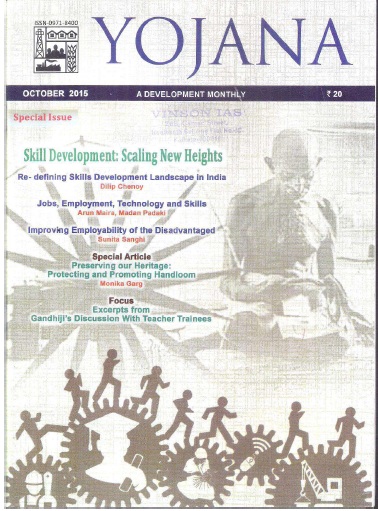
Skill India
What is Skill India?
Skill India is an initiative of the Government of India launched by Prime Minister Narendra Modi on 16 July 2015 with an aim to train over 40 crore people in India in different skills by 2022. The initiatives include National Skill Development Mission, National Policy for Skill Development and Entrepreneurship 2015, Pradhan Mantri Kaushal VikasYojana (PMKVY) scheme and the Skill Loan scheme.
The grand dream is to make India the skill capital of the world. It cannot be realized without the concerted efforts of the state, corporate, industries and individuals.
Moto: Kushal Bharat Kaushal Bharat
Statistics
~15 to 17 % of the global working population in 2022 would be Indian
There are 500 million in the workforce now in India of which 14% work in the organized sector and 86% in the unorganized sector. Those in the unorganized sector are either not well trained or their skill is not recognized in the market.
By 2020, average age of Indians would be 29 years
3/4ths of Indian population is unskilled
1 million young people would join the labour force every month for the next 20 years while 200 million people are stuck at low productivity
There are 1200 employment exchanges in India run by the government.
Only 300000 persons have been employed of the 40 million registered
53% of Indian employers find skill shortage as one of the prime reasons for unfilled entry level vacancies
Every year 63 million is being added to India’s working age population
India has to absorb 115 million youth into the workforce over the next 10 years
India has 883 million persons under 35 (66% of population)
Youth unemployment rate-12.9 %( 15 to 35 age group)
Overall unemployment rate-8.8%
India’s workforce-474.1 million
Rural workforce-336.9 million, urban workforce- 137.2 million (NSSO 2011-12)
60% self-employed, 30 % – casual workers, 10% – regular employees (of which 2/5th employed in public sector)
40.7 million registered in unemployment register
Population growth~1.5 % per year
Median age of Indian population:24
35 % population below 15
50 % population below 25
Annual Status of Education Report (ASER) 2013 Data
While there are ~430 million below 18 years of age only 229 million are enrolled in class 1 to 12.The gap may be due to financial constraints or lack of interest
Percentage gross enrollment in –
Secondary level education:63.21%
Tertiary level eduction:20.0%
Class 10:164.75 lakh appeared 34 % failed
Class 12:119.234 lakh appeared 22% failed
35% enrolled at primary level do not reach grade X
10million/26 million who appear in the examination do not pass Grade X
8 million/16 million who appear in the examination do not pass Grade XII
5 million/ 8 million go to college
11% of schools are manned by a single teacher. 40% of teacher positions in schools are vacant
56% of students drop out between high school and higher education
50 lakh graduates pass out every year.25 % technical graduates
Only 10% to 15% of the graduates are employable
Labour Market Scenario in India
30 % entrants in the labour market are illiterate, 24 % have only primary education, 20 % had dropped out before class V, 47.4% have dropped out before secondary education, only 3% have formal skills, 7% acquire skills informally, and 90% do not have any formal skill. Females receiving formal skill training are 2.79 million while males receiving the same are 8.63 million. Only~10% Indians are trained in some useful skill or the other while in Korea it is 93%
48 % are employed in agriculture which contributes to only 16 % of GDP
75 % of new job opportunities are skill based. But a large section of Indian labour force has outdated skills
59 million enterprises in the small scale unorganized sector employs 127 million
To train 40 crore persons by 2022, India would need ~1crore trainers across domains and areas of expertise
The world is to encounter the workforce shortage of 47 million people by 2020. By 2022, India will have a surplus of 56 million working age people
Why Skill India
In the words of the Mahatma,
“The brain must be educated through the hand. The teacher must learn the craft and correlate his knowledge to the craft. The craft cannot be separated from education.”
India has the potential to become the factory of the world with China’s exit from manufacturing.
If Indian youth do not find gainful employment it could lead to discontent which would result in increased conflicts and suicide rates (Demographic dividend or demographic disaster)
Demographic dividend does not mean just people; it means skilled, educated or employed people
India and other Asian countries are going through many transitions; farm to non -farm, rural to urban; unorganized to organized; subsistence self employment to formal wage employment and school to work
They offer a rich talent pool at low cost. At the same time developing countries like India and Brazil face huge skill gaps and thereby low employability.
India seems to create fewer jobs with every percentage increase in GDP than other developing countries
Skills are the bridge between good jobs and the workforce .Setting standards and quality of training is a pre requisite for skilling and its utilization.
Only a skilled workforce would lead to the success of initiatives like Make in India and
Digital India. Skill availability and accessibility to avenues for successful ventures can enhance the livelihoods of many
Challenges
The unemployed youth are not in education, training or employment.
There have neither formal entry points to training nor can they afford a skilling programme. Vocational courses are terminal as there is no vertical mobility from certificate to diploma to degree courses. Therefore these courses are not pursued by choice. These courses have low social acceptability. Lack of good infrastructure and poor quality of trainers and courses also make vocational training unattractive and less useful. SMEs’ preference for semi trained and untrained workers as they can be paid low are also a problem. There is also lack of standardization as different ministries offer different skill courses
Also the workplace is becoming more dynamic, volatile, uncertain, complex and ambiguous.
How to skill India?
Transformational education system aligned with skills can make students employable. Soft skills and interpersonal management skills are also necessary to successfully negotiate through the workforce. A basic requirement for skilling is to ensure retention in school by improving school infrastructure both physical and human
Pre requisites for Skilling-nutritional security, economic security, health security and security of business opportunity and development
ILO Youth Employment Network’s 4 Es for skilling:
Equal opportunities for all,
Employability,
Entrepreneurship,
Employment creation
There has to be a change in the pattern of economic growth as there is an overwhelming tilt towards the service sector. The manufacturing sector is yet to grow to it’s potential.
The approach to implementation of governmental programmes has to change
We have to create more jobs faster. We have to bring about a change in the Jobs-Enterprises-Technology-Skills ecosystem.
The Jobs-Enterprises-Technology-Skills (JETS) ecosystem
Enterprises and jobs are being transformed by technology. Retailing, publishing, public transportation etc. have seen sea changes in their operational models. Now small manufacturing units using 3D printers can have the scope and capabilities of a large factory with its many specialized machinery. Thus technology changes enterprises which demands new job portfolios which in turn requires new skills. The associations are mutual. The assembly line approach for skill development will no longer work as the requirements are varied and times uncertain. A young person who sets out early in life on a path towards an aspirational job at the end of the assembly line chain may find that the job for which she has qualified are no longer sufficiently available. The JETS ecosystem must be designed to enable young people to discover opportunities and jobs as they are and to be quickly able to learn the skills required. We need better learners not only good workers
The Employers’ Role
Employers must be an integral part of the skill development process as employers are compelled to change processes to survive dynamic competition. They have to actively pass on the changed skill set requirement to trainees and employees. Enterprises themselves must become faster and better learners. Employees are the appreciating assets of an enterprise. Employers would do well if they humanize their enterprises not only digitize them.
Enterprises for Skilling
Enterprises specializing in activities that assist people to learn and keep learning will have to be formed. Specialists in content development, training support, teacher development will have to be engaged. Government would have to protect customers’ interests by ensuring that quality standards are followed in these new enterprises. Competition regulation would make sure that established players are not crowding out new entrants. Government can also provide such facilities run as cooperative ventures with private partnership
Innovations are also the need of the hour. We need job creators over job seekers. This is possible by nurturing entrepreneurship.
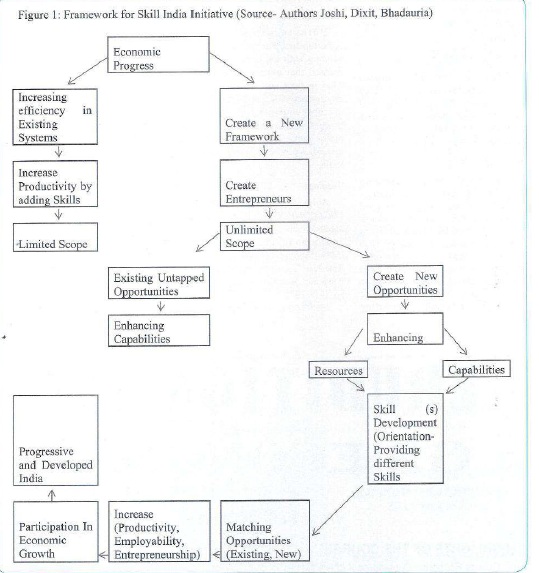
Job creation in rural India: India has to move past the village vs city concept. Ecosystems for decent livelihoods-sustainable and respectable should be created in villages. The emerging rural youth has an urban level of access to information, a similar or even higher hunger to learn, entrepreneurial spirit and even global aspirations. There is good penetration of technology in rural India and rural youth are comfortable using them. Technology can be used to map out jobs/careers/entrepreneurial opportunities, test skill achievement level, career counseling etc. There is a need to extend markets to rural areas which would provide last mile connectivity to rural India. Such new market places can provide new jobs and entrepreneurship opportunities
There is also a need to improve the quality of training. Training should be driven by the learner/trainee-the capability and strengths of the trainees and needs of the employers
Training cannot be peripheral, restricted to certain trades and urban centres. It needs to be market driven and inclusive
There is a need for infrastructure development in tier 2 & 3 cities and rural areas. Workplaces have to be where training centres are and vice versa
Role of ICT- Blended Learning
500 million would be connected to internet by 2022.Users in rural areas jumped from 29% to 50% in 2016. Women users would increase from 28 % in 2013 to 35 % in 2018.Internet can be used to provide edutainment. Online learning modules provide freedom of location and 24/7 access. Blended learning incorporates technology mediated instruction with face to face learning and collaborative learning(learning from peers) .It can include an open platform for e- content on skill development, Massive Open Online Courses(MOOCs),virtual classrooms etc.
Advantages of Blended Learning:
1) Reach
2) Normalization of skill variation among students from different educational backgrounds
Blended Learning Models
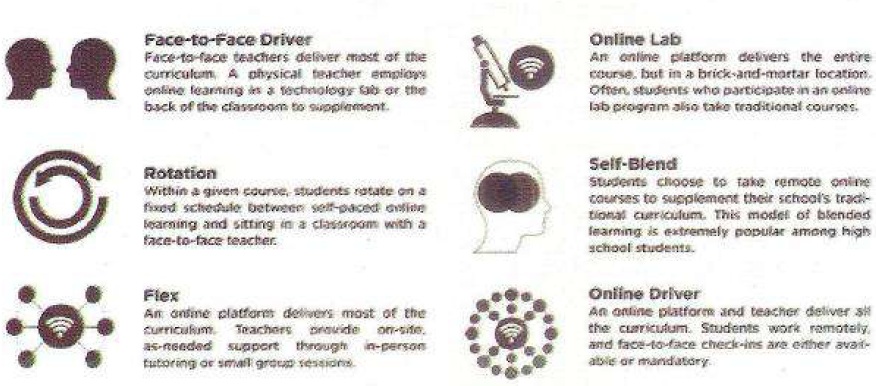

Strategies
1) Policy framework to be put in place on how and where blended learning(BL) will be integrated to the existing systems
2) Policy on how to assess the learning outcomes of BL – e-assessment
3) Optimal use of existing infrastructural capabilities to extend BL
4) Looking at innovative sources to find capable trainers
5) Invest in areas where there would be measurable impact
Standardization of training content is easier if there is a common e-platform. Concepts like Skills on wheels can take training to remote areas. ICT enabled impact assessment like Social Return on Investment (SROI) can attract private players to invest in skilling
There has to be location specific strategies for skilling as the target demography is diverse (different educational and financial background). Labour Management Information System (LMIS) has to be put in place to map demand and supply
There is a critical need to vocationalize professional programmes by developing curricula in line with industry needs, create infrastructure needed for it and design student assessment accordingly.
What are to be done to revitalize vocational training?
1) Provide vertical and lateral mobility from certificate to diploma to degree courses.
2) Involve industry in all aspects of vocational training
3) Create standard curriculum for vocational training and assessment systems
4) Meet faculty requirement by training
National Skill University (NSU)
Mainstreaming skill training in schools and colleges is the need of the hour. Multipoint entry and exit from the formal to vocational education systems and the job markets is a necessity. There has to be options to acquire skill certification, soft skills and recognition of prior learning. The NSU can do all these and integrate skill initiatives of the centre with those of the states.
NSU can subsume the existing colleges, ITIs, polytechnics etc as subcentres
Skill content and pedagogy created through industry coordination has to be made available in all languages and models of delivery (face to face, ICT enabled etc).Skill supply and demand has to be studied through skill research. Collaborations with foreign and local players are required to set the standards and deliver on quality. Skilling the trainers are also a necessity. Community college networks have to be set up. Work integrated training models and skills integrated scholarships have to be provided.
CSIR/DRDO labs have to conduct mandated research that helps the industries.
IPR-Patent-Entrepreneur cells have to be opened in IITs that promote research in niche technology areas like mining, oil exploration, power, biosciences, bio engineering etc.
These researches should also drive the downstream activities taking place in the vocational institutes and MSMEs such that integrated research takes place in every field in a decentralized manner
The NSU can be the integrator of the subsystems and should also work for the implementation of the research carried out under the leadership of premier institutions
New financial models to sustain education have to be introduced. Also impetus to vocational education in the form of a new division in schools that advocates vocational education can do wonders
National Policy on Skill Development and Entrepreneurship 2015 has identified 10 enablers of skilling .They are:
Aspiration, Capacity, Quality, Synergy, Mobilization and Engagement, Global Partnership, Outreach and Advocacy, ICT enablement, Development of trainers and Inclusivity
OECD Skills Strategy identifies 3 key areas for action by governments:
- Developing relevant skills
- Activating these skills
- Putting these skills to some use
Skill and placement targets have to be set at aggregate and sectoral levels and a robust national tracking system should be in place
There should be emphasis on traditional jobs as well. The responsibilities divided among ministries have to be clubbed together
Skilling the disadvantaged
Many in India are disadvantaged based on economic and social factors. School dropouts and illiterates end up in low paid jobs which lead to the vicious cycle of intergenerational poverty. The disadvantaged are generally SCs, STs, women, school dropouts, illiterates, differently-abled etc.
(There are 2.68 crore differently abled and 1.57 crore are in the working age group)
Rural disabled are significantly disconnected from skills and thereby the labour market.
Rural population in general has access to only education of poor quality
Skilling the rural workers in agriculture and related activities with linkages to finance, labour and product markets can go a long way in improving the livelihoods of the rural poor. Skill requirement of the informal sector can be met by linking apprenticeship training with formal schooling
Girls dropout from schools more than boys partly due to unavailability of hostel and transport facilities. Also skill programmes are biased towards trades favourable to men. Broad basing of trades and doing away of occupation based gender segregation are an urgent requirement to draw women to the workforce
Differently- abled are subjected to multiple challenges- lack of education and training, limited access to finances, unsuitable nature of workplace/occupation, negative employer perception etc.
Access to education, training and employment continues to be determined by socio-economic status, gender, infrastructure facilities etc. The diversity of target groups in terms of geography, gender, socio- religious affiliations pose challenges to policy implementation
Possible Interventions:
- Linking education and training with the world of work
Recognition of prior learning – restructure informal training so as to certify the skill level of workers in a sector
- Addressing the needs of people in difficult areas (J&K, LWE-affected states) by targeted intervention
E.g. setting up skilling and training centres in Madarasas
- Involving all stakeholders like trade unions, employers’ organisations, local rural and urban bodies and civil society organisations
There are overlapping schemes implemented by government departments at the state and central levels. This can be fine tuned by inter ministerial state- centre coordination
PPP model of skilling seems to increase overall efficiency of the process
The unorganized sector employs the maximum number of persons after agriculture but unorganized sector is associated with limited professional skills, low incomes, low productivity and low capital investment. These limitations can be rectified by interventions.
Promoting Skilling of Women
There are many factors that inhibit women from taking up skill training. Sectors like manufacturing are sometimes prohibitive to women which force women to take poorly paid part time jobs while the IT sector offers the remuneration and flexibility required. Then there are factors that inhibits the employment of skilled women
The main hindrances to women joining the workforce are:
- Lack of publicly provided childcare which prevents women from remaining in the labour force during childbearing years. Also, patriarchal norms of Indian society dictate that child care is the women’s responsibility
- Extra expense employers incur to employ women. The cost of maternity and childcare benefits would have to be borne by the employer
- Notorious lack of safety to women in public spaces
Industry- wise cesses or levy on all employees for childcare can be made mandatory so that the burden of childcare falls evenly on all and not only on women. Company sponsored commute can be made mandatory for those companies which requires employees to take up night shifts
Tribal employment possibilities and concerns
Tribal youth will have to be educated in life skills, enterprise management for self employment, technical skills and practical skills
There is a need to expand existing livelihood systems (agriculture, cottage industry etc.), build skills for job market outside rural non farm sector (RNFS) and nurture the skills of the self employed
Literacy rate among Scheduled Tribes- 59 %( males-68.5%, females-49.4%)
The resource base and the socio-economic heritage of tribes are eroding. They are to be prepared to cope with the changes. The aspirations among tribal youth are rising but there is lack of skills and non- existent access to capital. Vocational education is the key to improve the lot of tribal’s.
Findings of Mo Tribal Affairs and UNDP commissioned study
There is a general low level of education among tribal people.
Access to skilled training is limited
The aspirations of tribal youth are incommensurate with existing status
Tribal youth prefer service sector above others. They prefer skill training locally with subsidy support
There is a need to address the livelihood aspirations of the tribal youth and promote entrepreneurial skills in tribal areas
Sectors where tribal youth can be skilled and employed are divided as:
Green sectors: sustainable agriculture, floriculture, organic production, horticulture, forestry, animal husbandry, renewable energy production and distributed waste management, eco tourism and the like
Grey Sectors: non farm sector like manufacturing agricultural implements, furniture making, handlooms, wooden art, metal art, construction, transport and related activities
Service Sector
Geo-local service sector: services provided at a specific point-repairs, hotel and restaurant, retail trade, transport services, healthcare, fabrication, tailoring, leather work, catering etc,
Go anywhere service sector: electrician, plumber, mason, carpenter etc.
What is to be done?
- Orientation and induction of tribal youth on skill development and employability viz. awareness generation camps and sensitizing workshops
- Evolving different models of development-subsidy based/revenue based, residential programmes/ outreach programmes, long duration study/short duration study etc.
- Collaboration with existing government skilling centres like ITIs
- Establishment of ITIs at block and cluster levels in tribal areas
- Diversification of present courses by increasing options based on labour market requirements
- Building resource pool of vocational trainers and sensitizing them on tribal culture
- Using ICT to reach remote areas
- Leveraging existing government schemes
- Incentivizing industries to absorb tribal youth into employment
- Promoting interface between ITIs and employment exchanges in tribal areas
- Providing assured job placement and post training
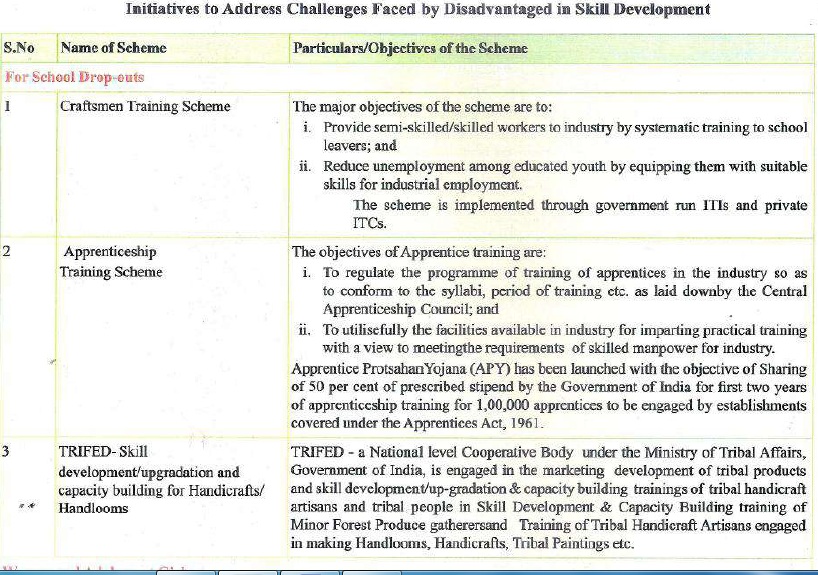
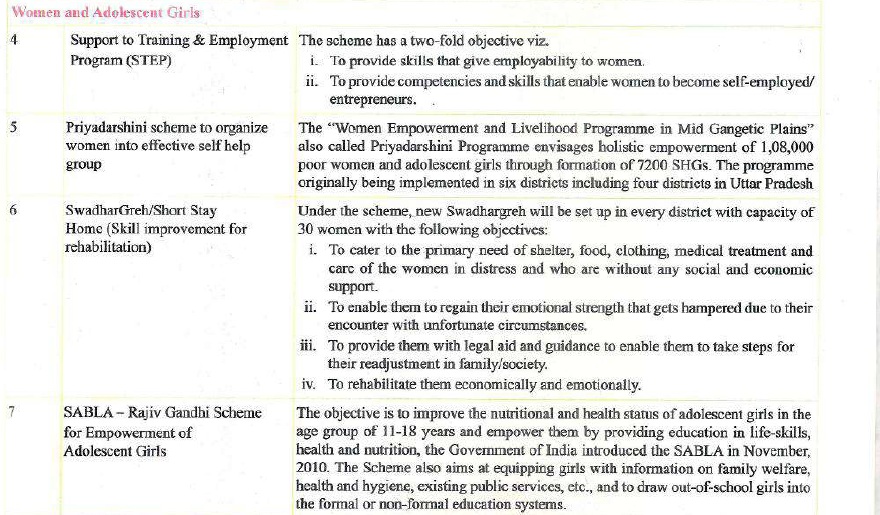

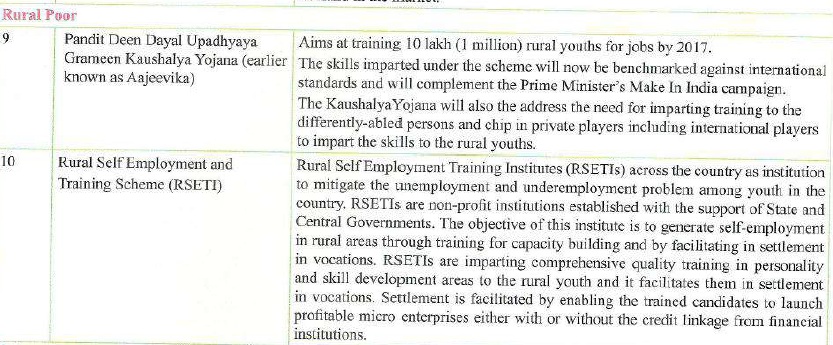

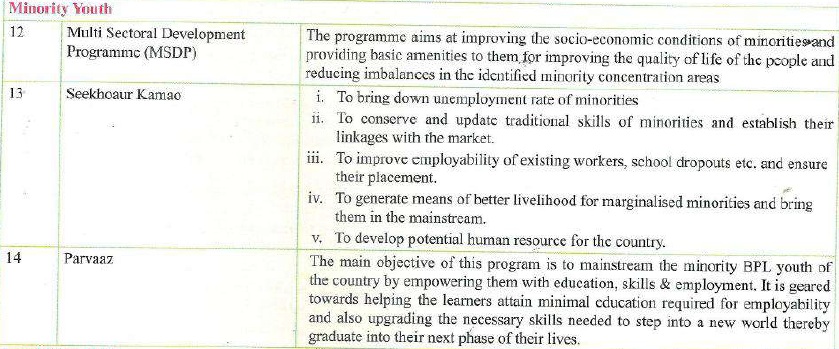

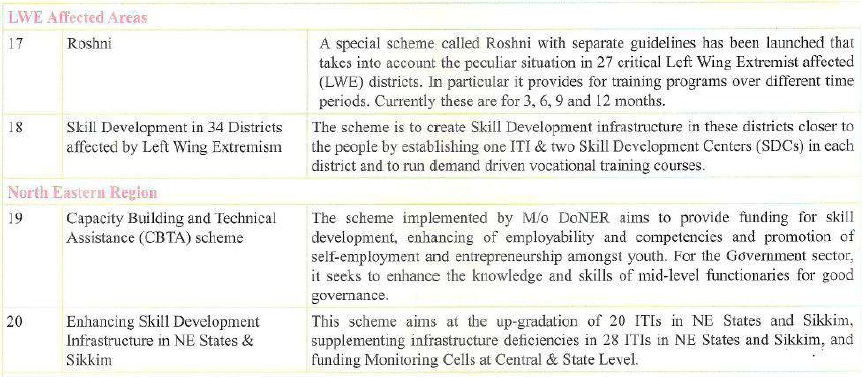


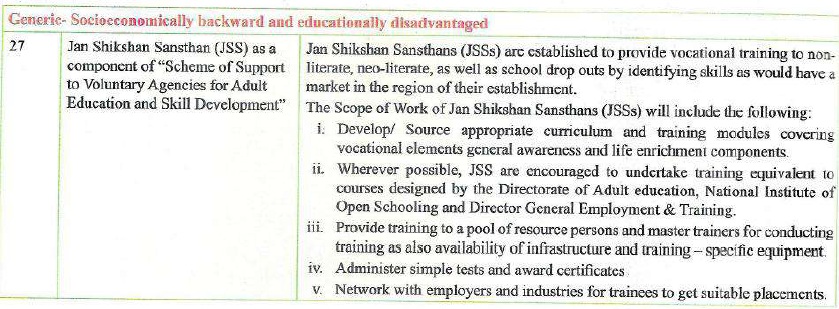 Ministry: Ministry of Skill Development and Entrepreneurship
Ministry: Ministry of Skill Development and Entrepreneurship
- NSDC– National Skill Development Corporation is a PPP based organisation under the Ministry of Skill Development & Entrepreneurship. It aims to promote skill development by assisting in the creation of large, quality, for-profit vocational institutions. Under the organization there are 37 Skill Councils, 235 training partners and 3611 training centres in 450+ districts. It formulates the National Occupation Standards for different job roles as per the National Skills Qualification Framework.5.5 million persons have been trained and 61 % placed as of Oct 2015 by NSDC
- Pradhan Mantri Kaushal VikasYojana implemented through NSDC under Mo SDE. It provides monetary reward through Direct Benefit Transfer to those successfully trained. 24 lakh persons will be imparted training in a year
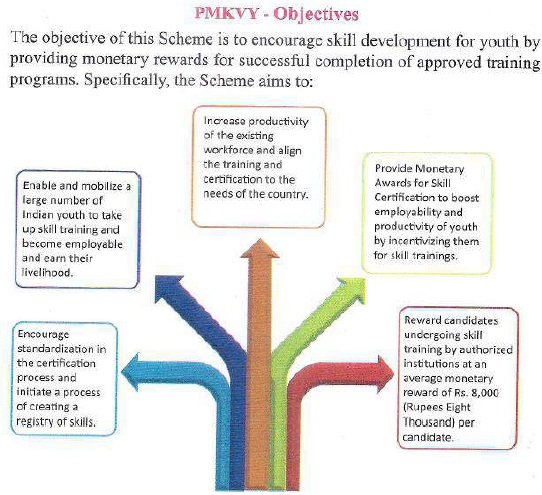
- Nai Manzil: to enable minority youth who do not have a formal school-leaving certificate to obtain one and find better employment
- USTAAD: The Scheme aims at upgrading Skills and Training in preservation of traditional Ancestral Arts/Crafts of minorities.
- Vidyalakshmi – web based portal launched on August 15, 2015.It was launched for the benefit of students seeking educational loans as per the objectives of Pradhan MantriVidya Lakshmi Karyakram .The portal provides information about loan schemes and facility to apply for loans among other functionalities.
- National Web portal for Apprenticeship Training: Website caters to graduates, diploma holders, 10+2 pass outs, and vocational certificate holders. It provides connectivity among all stakeholders including students, employers and technical institutions across the country. Slogan: Sashakt Yuva, Samarth Bharat
- Integrated Skill Devt. Scheme (Mo Textiles): To address the trained manpower needs of textiles and related segments including Handicrafts, Handlooms, Sericulture, Jute, Technical Textiles etc, by developing an integrated framework of training based on the industry needs
- National Skill Development Mission is outcome focused rapid skilling mission aligning demands of employers with aspirations of citizens for sustainable livelihoods.It aims to
Ø Establish standards,
Ø Build a national database(LMIS)
Ø Build capacity for skill development in unorganized sectors
Ø Create transitional pathways to formal training
Ø Support weaker sections through focused outreach programmes
Ø Provide high quality options for long term skilling
Ø Leverage existing infrastructure
Ø Offer passage to overseas employment
Ø Create social awareness of skilling etc
- PM’s Skill Devt Fellowship
Ø 3 years work cum learning opportunity
Ø Fellows are to act as skill development facilitators and assist State Skill devt Missions (SSDMs)
Ø Fellows are to conduct socio-economic analyses of the local areas at block level for ascertaining the gap between skills and needs of youth
Ø Fellows are to understand the needs of MSME units at the district level
Ø They are to facilitate credit linkages with banks and other financial institutions for skilling
Ø They are to provide f/b to SSDMs on skill devt. Initiatives
. Skill Devt Funding
NSDC provides skill devt. funding either as loans or equity grants. Detailed evaluation is done before selecting proposals
. Apprenticeship Protsahan Yojana: Under the yojana 50% of prescribed stipend to the apprentices engaged by eligible establishments particularly in manufacturing sector and other establishments covered under the Apprentices Act, 1961is shared by Government of India for the first two years of training
. National Skill Development Authority’s Skill Development Initiative Scheme provides certification in Modular Employability Skills (MES)
Other schemes and policies associated with skilling
RTE 2009
RMSA
Kasturbha Gandhi Balika Vidyalaya Residential Programme
Swachh Bharat Abhiyan
National Literacy Mission (target group 15-35 age group cohort)
National Commission for Enterprises in the Unorganised Sector(NCEUS) an advisory body to small enterprises established in 2004
GoI has nurtured the skills ecosystem in close partnership with private sector and international agencies like private ILO,WB,OECD,EU among others
There is more focus on youth from the bottom of pyramid groups, women and Persons with Disabilities
Region specific skill development programmmes are also being initiated for North East, J& K and LWE affected states
To Read: National Policy on Skill Development and Entrepreneurship 2015
Also Read:-
Comments